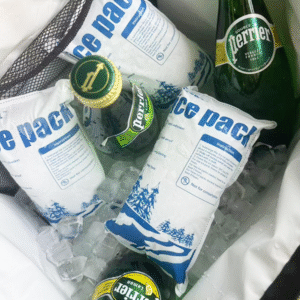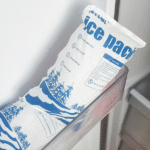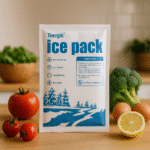Quanto pesa cada bolsa de gelo seco e aumentará significativamente os custos de envio?
Ao enviar produtos sensíveis à temperatura, O gelo seco é frequentemente necessário para garantir seu transporte seguro. No entanto, Compreender a quantidade de gelo seco pesa e como isso afeta os custos de envio é essencial para a otimização de custos. Este guia explica os diferentes tamanhos de embalagem de gelo seco, os fatores que influenciam os custos de envio, e estratégias práticas para minimizar as despesas enquanto aderem ao último 2025 Regulamentos de envio.
-
Quanto custa cada Pacote de gelo seco normalmente pesa?
-
Como o peso do gelo seco afeta os custos de envio?
-
Quais são as melhores práticas para minimizar os custos de envio com gelo seco?
-
Quais são as últimas tendências e regulamentos para 2025?
Quanto pesa cada bolsa de gelo seco?
O peso da embalagem de gelo seco varia de acordo com o tamanho da remessa, tipo de gelo seco usado, e a duração do envio. Em média, gelo seco usado em remessas pesa entre 5 para 50 libras. Remessas menores podem exigir apenas 5 libras, enquanto remessas maiores podem exigir até 50 libras ou mais, dependendo de fatores como a natureza das mercadorias e a duração do trânsito.
Tamanhos e pesos de bolsas de gelo seco
O gelo seco está normalmente disponível em três formas: blocos, Pellets, e discos. Cada forma tem diferentes características de peso e durações de resfriamento:
| Tipo de gelo seco | Faixa de Peso | Uso Comum | Duração do resfriamento |
|---|---|---|---|
| Blocos de gelo seco | 5-25 libras | Remessas de longa duração | Até 72 horas |
| Pelotas de gelo seco | 1-10 libras | Remessas mais curtas | 12-48 horas |
| Discos de gelo seco | 5-10 libras | Pequenas remessas | 12-24 horas |
Dica: Para remessas longas, blocos de gelo seco são preferidos, enquanto pellets e discos são mais adequados para remessas de menor ou menor duração.
O peso do gelo seco afeta os custos de envio?
O peso do gelo seco é um fator chave na determinação dos custos de envio. As transportadoras geralmente cobram com base no peso e no volume (peso dimensional) do pacote. Veja como o gelo seco afeta os custos de envio:
Custos de envio baseados no peso:
Quanto mais pesado o gelo seco, quanto maior o custo de envio. Pacotes mais pesados naturalmente incorrem em tarifas mais altas, especialmente quando o pacote excede os limites de peso.
Preço de peso dimensional:
Além do peso real, as transportadoras podem cobrar com base no volume do pacote. Pacotes volumosos contendo gelo seco podem incorrer em taxas mais altas, mesmo que não sejam especialmente pesados.
Taxas de manuseio de materiais perigosos:
Como o gelo seco é classificado como um material perigoso, transportadoras podem aplicar taxas de manuseio adicionais, especialmente para remessas internacionais que exigem rotulagem especial, embalagem, e documentação.
Como o peso do gelo seco afeta o doméstico vs.. Envio Internacional?
O peso do gelo seco pode ter um impacto diferente nas remessas nacionais e internacionais:
Envio Doméstico:
Para remessas domésticas, os custos são geralmente determinados pelo peso e tamanho do pacote. Grandes operadoras como UPS e FedEx têm taxas específicas para remessas contendo gelo seco. Os custos de envio podem ser influenciados pelo peso, tamanho, e o tipo de serviço (durante a noite, chão, etc.).
Envio Internacional:
Para remessas internacionais, o gelo seco é classificado como perigoso bem, o que resulta em taxas de manuseio adicionais, rotulagem especial, e papelada. Além disso, muitas regulamentações internacionais limitam o peso máximo de gelo seco que pode ser enviado em um pacote, levando a custos globais mais elevados.
Comparação de custos para diferentes tipos de envio:
| Tipo de envio | Impacto nos custos | Encargos Adicionais |
|---|---|---|
| Doméstico | Peso + Tamanho | Possíveis sobretaxas de combustível |
| Internacional | Peso + Tamanho + Taxas de mercadorias perigosas | Manuseio especial, documentação, rotulagem |
Você pode reduzir os custos de envio com gelo seco?
Embora o gelo seco possa aumentar os custos de envio, existem várias estratégias que você pode usar para minimizar essas despesas:
Embalagem Otimizada:
Usando embalagens isoladas de alta qualidade, como painéis isolados a vácuo (VIP), pode reduzir significativamente a quantidade de gelo seco necessária. Um melhor isolamento mantém a temperatura estável por mais tempo, reduzindo a necessidade de gelo seco excessivo.
Dimensionamento Eficiente:
Certifique-se de usar a quantidade exata de gelo seco necessária. Superestimar pode levar a custos desnecessários, enquanto subestimar pode arriscar a deterioração do produto. Cálculo adequado com base no tempo de trânsito e peso do produto é crucial.
Consolidar Remessas:
Se possível, combine várias remessas menores em um pacote maior. Essa abordagem permite distribuir o custo do gelo seco e a taxa de envio entre vários itens, em última análise, reduzindo os custos de envio por item.
Exemplo prático:
Uma empresa de transporte alimentos sensíveis à temperatura pode minimizar custos usando um contêiner de transporte isolado e escolhendo a quantidade correta de gelo seco. Esta estratégia garante que os produtos permaneçam seguros sem excesso de gelo seco, levando a custos de envio mais elevados.
2025 Últimas tendências em transporte e custos de gelo seco
Embalagens ecológicas:
A crescente demanda por sustentabilidade no setor de logística levou a inovações em materiais de embalagem ecológicos. Painéis isolados a vácuo (VIP) oferecem isolamento superior, reduzindo a necessidade de grandes quantidades de gelo seco. Esses materiais de embalagem não apenas reduzem os custos, mas também ajudam as empresas a cumprir as metas ambientais.
Mudanças regulatórias e conformidade:
AS 2025, regulamentos mais rígidos estão sendo aplicados no transporte de gelo seco, especialmente para remessas internacionais. As empresas devem aderir a novas IATA e USPS regulamentos, que incluem melhores requisitos de rotulagem e documentação.
Soluções alternativas de resfriamento:
Materiais de mudança de fase (PCMs) estão sendo introduzidos como uma alternativa mais sustentável ao gelo seco. Esses materiais fornecem resfriamento em temperaturas específicas e podem reduzir a dependência de gelo seco para certos tipos de remessas.
Insight de mercado:
A demanda por transporte marítimo de gelo seco continua a crescer com indústrias como produtos farmacêuticos e Serviços de entrega de alimentos. Inovações em embalagem e práticas sustentáveis são cruciais para reduzir o impacto ambiental do transporte marítimo de gelo seco.
Perguntas frequentes (Perguntas frequentes)
Q1: Como as empresas de transporte cobram pelo gelo seco?
As empresas de transporte cobram pelo gelo seco com base em seu peso e tamanho. Adicionalmente, eles podem aplicar taxas de manuseio de materiais perigosos, especialmente para remessas internacionais.
Q2: O gelo seco é considerado um material perigoso??
Sim, o gelo seco é classificado como materiais perigosos devido ao seu potencial para deslocar o oxigênio e causar asfixia em espaços confinados. Embalagem e manuseio especiais são necessários para remessas contendo gelo seco.
Q3: Como posso reduzir o custo do envio de gelo seco?
Otimize sua embalagem, Use a quantidade certa de gelo seco, e consolidar remessas para reduzir o custo total. Isolamento eficiente e cálculos precisos são essenciais para minimizar despesas desnecessárias.
Conclusão & Recomendações
Compreender o peso do gelo seco e seu impacto nos custos de envio é crucial para empresas que dependem de produtos sensíveis à temperatura. Otimizando a embalagem, calcular com precisão as necessidades de gelo seco, e permanecendo atualizado em 2025 regulamentos, Você pode garantir que suas remessas sejam seguras e econômicas.
Ações recomendadas:
-
Para eficiência de custos: Use embalagem isolada para reduzir a quantidade de gelo seco necessário.
-
Para remessas domésticas: Evite superestimar as necessidades de gelo seco e escolha embalagens que minimizam o tamanho.
-
Para remessas internacionais: Esteja ciente das taxas de materiais perigosos e cumpra os regulamentos internacionais.
Sobre Tempk
A Tempk fornece soluções inovadoras em logística da cadeia de frio, especializado em embalagem com temperatura controlada e métodos de envio eficientes. Usamos materiais isolados avançados para garantir que suas remessas permaneçam seguras e econômicas, ao mesmo tempo em que aderimos aos mais recentes padrões regulatórios.
Entre em contato com Tempk hoje para discutir como podemos ajudar a otimizar suas necessidades de envio de gelo seco.
























